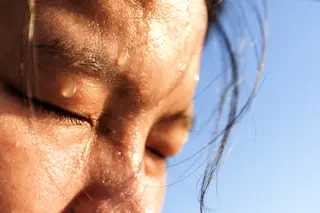“Look in a mirror,” begins You Are All Sanpaku, a health book from 1965 written by macrobiotic advocate and anti-war protestor George Ohsawa. There you see the whites of your eyes and, if you have sanpaku, a space between the iris and lower lid. This white crescent indicates “a grave state of physical and spiritual illness […] and an extraordinary susceptibility to disease, accidents and tragic death.”
Having stared in their eyes (or pictures) he diagnoses many celebrities of the day, including Brigitte Bardot, J. Edgar Hoover, Ted Kennedy, Sid Caesar, Bette Davis and Jackie Gleason. All lived long lives, unlike alleged sanpaku John F. Kennedy, whose death Ohsawa predicted in a 1963 newspaper interview with Tom Wolfe for The New York Herald Tribune.
Sanpaku Eye Theory
In Ohsawa’s sanpaku theory, the lower-lid condition is called “yin sanpaku” while “yang sanpaku” is less common and refers to a space above the iris and an inner disturbance. The most famous case of yang sanpaku is probably Charles Manson, based on his bug-eyed 1969 cover of Life magazine, although he looks less sanpaku in other photographs.
Physiognomy
The theory, which means “three whites,” comes from Japanese face-reading (physiognomy), wherein an oval face signals nobility. Shaggy eyebrows indicate duplicity. A large mouth shows strength. And an up-turned nose goes with self-indulgence, according to this guide.
Sanpaku is back with a new list of celebrities said to suffer – Billie Eilish, Diana Ross, Aubrey Plaza, Anya Taylor-Joy, James Spader, Giovanni Ribisi – mostly Yin cases, all still living. Do they have anything to worry about? Probably not.
The Science of Sanpaku Eyes
Yin sanpaku, aka "scleral show" in medical terms, affects about half of people to some degree, according to a 2020 study that measured 123 volunteers who lacked eye diseases. Some 19 percent of the total had a more pronounced scleral show, a millimeter or more. That’s about as common as having blue eyes, dimples or a unibrow.
Scleral Show Causes
The normal aging process can also cause the lower eyelid to sag and reveal more white, though this is not completely innocuous. Dryness may follow, and with no blood vessels of its own, the light-catching cornea relies on tears and the aqueous humour inside the eye for replenishment. With less of these, the curving structure is at greater risk for disease.
People with scleral show are also more prone to catching junk in their eyes, and slipping eyelids are more likely to sustain lacerations or other damage. Conversely, damaged eyelids are more likely to develop scleral show.
Other Causes of Sanpaku Eyes
Cosmetic eyelid surgery can do the same by damaging muscles, though procedures have been developed to repair this. Also, an autoimmune disease affecting the thyroid, Grave’s Disease, can cause eye tissue to swell and protrude from of the orbital bones, revealing the whites.
But in most cases, the explanation is far more hum-drum. According to a 2020 paper, most people with sagging lower lids are near-sighted, and because myopic eyes tend to have larger diameters, the lids get less support, slip down and there you have sanpaku eyes.














